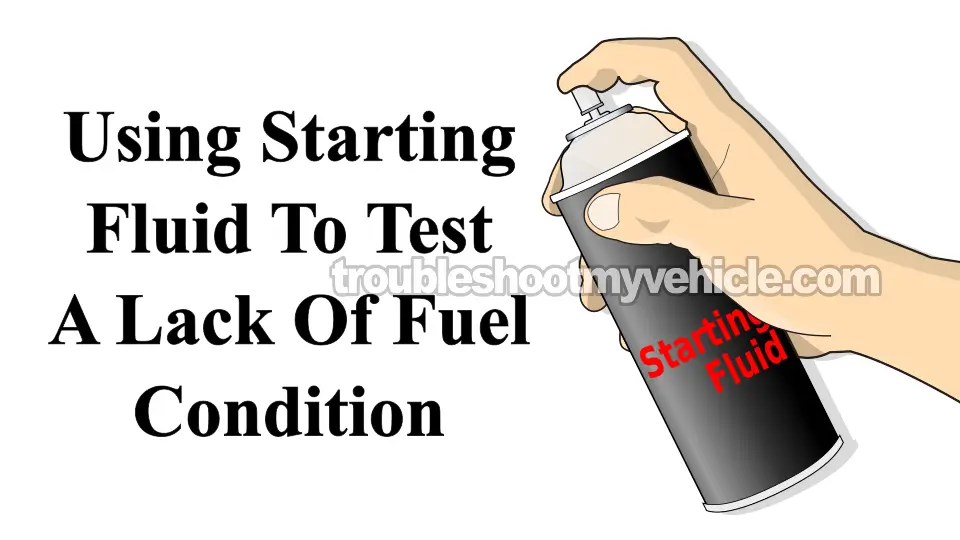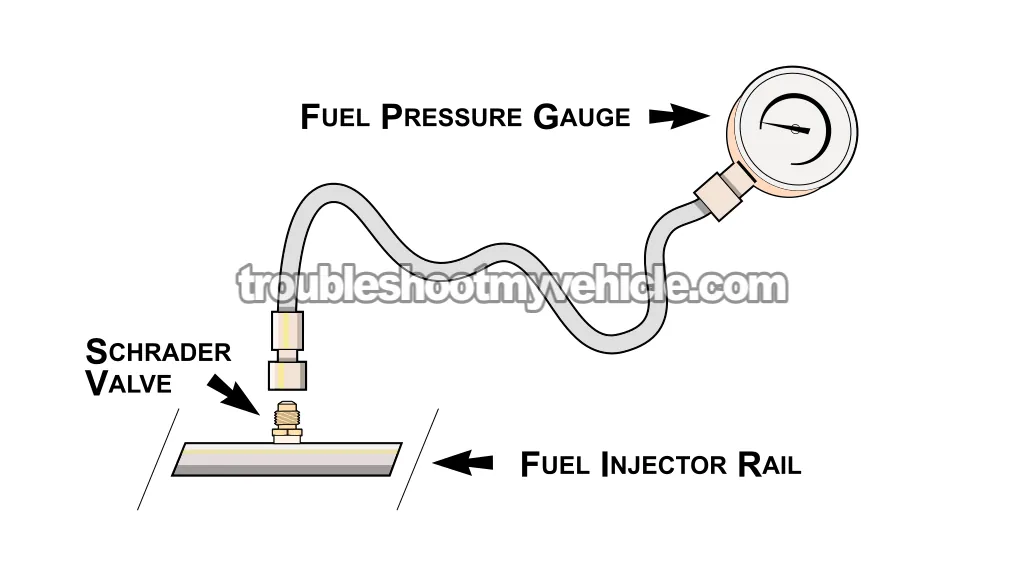
With a fuel pressure test gauge and a few minutes, you can find out whether your fuel pump is delivering the right pressure —or falling short.
In this tutorial, I'll walk you through the process step by step, covering all three test methods: key-on engine-off (KOEO), engine running, and scan tool activation of the fuel pump.
So if your 2002–2005 4.7L V8 Dodge Ram pickup isn't starting or feels sluggish on the road, and you suspect a weak or failing fuel pump, this fuel pressure test will take the guesswork out of your fuel system diagnosis.
Contents of this tutorial:
APPLIES TO: This tutorial applies to the following Dodge Ram pickups:
- 4.7 V8 Dodge Ram 1500 Pickup: 2002, 2003, 2004, 2005.
WIRING DIAGRAMS:
- Fuel Pump Circuit Wiring Diagram (2002 4.7L V8 Dodge Ram Pickup).
- Fuel Pump Circuit Wiring Diagram (2003 4.7L V8 Dodge Ram Pickup).
- Fuel Pump Circuit Wiring Diagram (2004, 2005 4.7L V8 Dodge Ram Pickup).
ENGINE NO-START DIAGNOSTICS:
2006-2009 FUEL PUMP TESTS:
Symptoms Of A Bad Or Failing Fuel Pump
On the 2002–2005 4.7L Dodge Ram, fuel pump problems usually show up in one of two ways: the pump either stops working altogether, or it begins to weaken and can't keep up with engine demands.
- Total failure: The fuel pump doesn't activate at all —no fuel pressure, no engine start.
- Weak output: The pump runs but delivers low pressure, which causes performance issues and driveability complaints.
In cases of a weak fuel pump —where the engine still starts but doesn't get enough fuel— you'll often notice symptoms like:
- Rough or unstable idle —the engine shakes in idle speed RPMs, whether the transmission is in Drive or not.
- Extended cranking —the engine takes longer than normal to start.
- Lack of power —you press the gas, but the engine hesitates or falls flat.
- Backfiring through the intake —especially under load or rapid acceleration.
- Lean condition trouble codes —such as P0171 (Bank 1 lean) or P0174 (Bank 2 lean), or both.
Whether you're dealing with a crank-no-start condition or engine performance issues, testing fuel pressure is one of the fastest ways to confirm or rule out a bad fuel pump —and you only need a basic fuel pressure gauge to do it.
Fuel Pressure Specifications
| 2002-2005 | |
|---|---|
| 4.7L | 44-54 PSI (Key On Engine Off) |
Where To Buy A Fuel Pressure Test Gauge
A fuel pressure gauge is one of those tools you definitely want and need to have in your tool box.
You can find fuel pressure test gauges at most auto parts stores or online. The following kits offer solid value and are compatible with the fuel system on your 2002–2005 4.7L V8 Dodge Ram pickup:
Disclosure: As an Amazon Associate, I earn from qualifying purchases. If my tutorials help you, using these links is an easy way to support the site at no extra cost to you. Thank you!
TEST 1: Checking Fuel Pressure With A Fuel Pressure Gauge
Alright —to test your pickup's fuel pump, we're going to connect a fuel pressure gauge to the Schrader valve located on the passenger side fuel injector rail.
This valve gives us direct access to the fuel system, so we can see exactly what kind of pressure the pump is delivering.
The test procedure is straightforward and will quickly reveal whether your pickup's fuel pump is healthy, struggling, or completely dead.
I'll walk through three common testing methods: engine cranking, key on engine running (KOER), and key on engine off (KOEO) using a scan tool.
Here's the game plan:
- 1
Wrap a shop towel around the Schrader valve. This helps catch any fuel that might leak when connecting the gauge.
- 2
Connect your fuel pressure gauge to the valve. Hand-tighten the connection only —no need for tools.
- 3
Have a helper turn the key ON and OFF several times (without starting the engine) while you monitor the gauge.
Check for leaks at the connection —tighten by hand if needed.
KOER Test —Engine Starts And Idles
- 4
Start the engine and let it idle.
- 5
Observe the fuel pressure gauge reading.
Compare your reading to the correct spec: 44-54 PSI.
Key On Engine Cranking Test —Engine Doesn't Start:
- 4
Have a helper crank the engine.
- 5
Observe the fuel pressure gauge reading when he let's go of the key.
Compare your reading to the correct spec: 44-54 PSI.
KOEO With Scan Tool —Whether The Engine Start Or It Doesn't:
- 4
Connect your scan tool to the diagnostic port (DLC).
- 5
Turn the key to ON but don't crank or start the engine.
- 6
Use the tool to manually activate the fuel pump relay.
- 7
Watch the pressure gauge.
Confirm that pressure builds to spec: 44-54 PSI.
Let's see what your fuel pressure test result is telling us:
CASE 1: 0 PSI on the gauge. This almost always means the fuel pump is dead and not supplying fuel.
But before replacing it, confirm the fuel pump fuse isn't blown (located in the Integrated Power Module):
- 2002: Fuse #44 (20A).
- 2003-2005: Fuse #17 (15A).
If the fuse is OK and all 8 COP ignition coils are sparking, you can conclude the fuel pump is bad and needs to be replaced.
This in-depth tutorial explains how to test the ignition coils:
CASE 2: Pressure is below spec. This points to a failing fuel pump. It's working, but not delivering enough volume or pressure to keep the engine running right. Replace it before it completely fails.
CASE 3: Pressure matches the correct spec. Good news! The fuel pump is working properly.
If your Dodge Ram still won't start, the problem lies elsewhere —this in-depth tutorial will walk you through what to check next:
TEST 2: Using Starting Fluid To Confirm Lack Of Fuel

I've been using this method —the starting fluid test— for years to check if a no-start issue is being caused by a lack of fuel. In fact, it's often the first test I run when diagnosing an engine that won't start.
The test is simple: spray starting fluid into the engine and crank it. If the problem is fuel-related, the engine will fire up and run for a few seconds —until the fluid is burned off.
Now, it's worth noting that this isn't the most precise way to diagnose a bad fuel pump —but it's a fast and effective way to get started.
NOTE: To get an accurate result, make sure all 8 ignition coils are delivering spark. Otherwise, the test may give you a false negative.
IMPORTANT: After spraying the fluid into the throttle body, be sure to reconnect the air intake duct —even if you don't clamp it down. This reduces the chance of a backfire startling you (or worse) when you crank the engine.
Here are the test steps:
- 1
Remove the intake air duct from the throttle body. No need to fully remove it —you'll reconnect it shortly.
- 2
Open the throttle plate and spray starting fluid into the bore.
Once sprayed, reconnect the air duct (again, no need to fasten it —just set it in place). - 3
Crank the engine —only after the duct is back on and you're clear of the engine bay.
- 4
You'll get one of two results:
1.) The engine starts briefly, then dies.
2.) The engine just cranks and never starts.
Let's break down what those results mean:
CASE 1: The engine started and ran briefly. That confirms the engine isn't getting fuel —fuel delivery is the issue behind your no-start condition.
Your next step is to confirm it with a fuel pressure gauge test. Go to: TEST 1: Checking Fuel Pressure With A Fuel Pressure Gauge.
CASE 2: The engine did not start at all. This typically means fuel is not the problem —you may be dealing with an ignition or mechanical issue.
Still, because this isn't the most precise diagnostic method, it's a good idea to follow up with a proper pressure check using a gauge. Go to: TEST 1: Checking Fuel Pressure With A Fuel Pressure Gauge.
More 4.7L V8 Dodge Ram Pickup Diagnostic Tutorials
I've written quite a few tutorials for the 4.7L V8 Dodge Ram pickup. You can find them in this index:
Here's a small sample of the tutorials you'll find in the index:
- How To Test For A Blown Head Gasket (2002-2009 4.7L V8 Dodge Ram Pickup).
- How To Test The Fuel Injectors (2002-2009 4.7L V8 Dodge Ram Pickup).
- How To Test The CKP Sensor -P0320, P0335, P0339 (2002-2010 4.7L V8 Dodge Ram Pickup).
- How To Check For Vacuum Leaks With Carb Cleaner Spray (2002-2009 4.7L V8 Dodge Ram Pickup).

If this info saved the day, buy me a beer!





